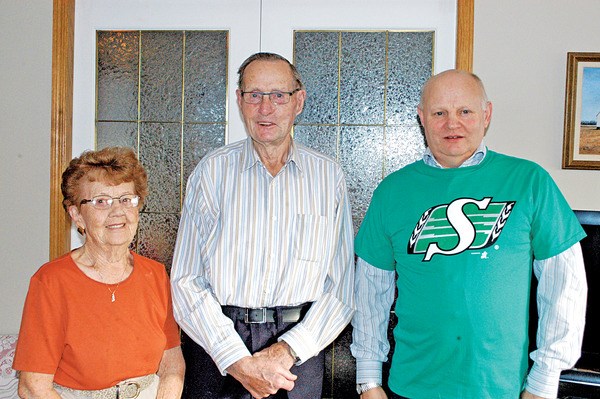Jan Lindbergh came all the way from Billeberga, Sweden, last month, to visit his Canadian farm host family, Ray and Jeanne Cumming of Unity. Lindbergh met the Cummings when he came to Canada under a young farmer student program in 1976.
Foreign agricultural trainees were common on area farms in the 1970s. Jeanne said they started taking trainees in 1969 and had one every year until at least 1985. Their first trainee also visited earlier this year. "They do come back," she said, with a smile.
With many farms in the area hosting trainees, the students from different countries used to gather in the Cut Knife bar Wednesday evenings.
Recognizing Unity had grown, Lindbergh couldn't say much else about change in the Town of Unity. That's because, in 1976, if he or the Cummings went to town, it was to Adanac they went - not Unity. The biggest change in the intervening years, for Lindbergh, is the virtual disappearance of Adanac.
When he was first here, there was a grocery store, garage and grain elevator at Adanac. The Adanac Hall hosted social gatherings. The elevator is gone and there are no businesses left in Adanac. Even the Adanac Hall has been moved to Unity.
"There is nothing left at Adanac that I can see," Lindbergh said, noting only one person was even there as a resident.
Today, as then, the biggest difference in farming between the two countries is size. A family farm here is 2,000 acres; in Sweden, 2,000 acres would be "much more than a family farm."
His father made a living on 60 to 70 acres. "That was a family farm," Lindbergh says. He himself has 110 acres, although he now rents out the land.
Many more winter crops are grown in Sweden. The European Union has mandated 60 per cent of crops must be winter crops but, even years ago, about 50 per cent of crops grown in Sweden were winter crops.
Even crops planted in the spring, such as sugar beets, go into land which is prepared the year before with fall plowing. In comparing, Lindbergh said, "You don't even break the land here before the winter. You just combine and then it's done."
As for changes in Canadian farming from 1976 to today, he said, "Now you straight combine everything but at that time you swathed everything." Granaries have changed, going from flat floors to hoppers on the bottom. Grain used to be left in the field much more.
The loss of elevators and building of grain terminals is another big change. Elevators used to be "a landmark here in Canada but you hardly see them now."
Today Lindbergh runs a seed cleaning plant and chicken slaughter plant in Sweden. He designed the seed cleaning equipment himself and can separate wheat and barley seeds. He thought he and his wife would close the slaughtering plant as volume at the seed cleaning plant increased, but they are becoming busier and busier with slaughtering as other area slaughter houses close down.




